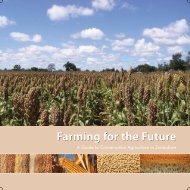Restoring the Soil - Canadian Foodgrains Bank
Restoring the Soil - Canadian Foodgrains Bank
Restoring the Soil - Canadian Foodgrains Bank
Create successful ePaper yourself
Turn your PDF publications into a flip-book with our unique Google optimized e-Paper software.
A Brief History of Green Manure/Cover Crops52. A Brief History Of Green Manure/Cover CropsGreen manures and cover crop systems have been used for at least 2,000 years. TheRomans wrote papers advising people on how best to use green manures. In <strong>the</strong> richercountries of Europe and <strong>the</strong> United States, green manures were by far <strong>the</strong> most commonmethod of maintaining soil fertility until <strong>the</strong> end of <strong>the</strong> Second World War.Some books from <strong>the</strong> 1930s include a tremendous amount of information aboutgreen manure systems in <strong>the</strong> tropics—information that today has been almost totallyforgotten. 2Since 1945, <strong>the</strong> ability of organic matter to effectively fertilize <strong>the</strong> soil has oftennot been emphasized or even mentioned in crop production manuals or agriculturetextbooks (Photos 1, 2, 3 and 4 show examples of <strong>the</strong> impact of organic matter inimproving crop yields).History shows beyond doubt that green manuring and gm/cc systems are capable ofmaintaining soil fertility for thousands of years. After all, <strong>the</strong>y have done precisely thatin virtually all <strong>the</strong> world’s different soils, environments and farming systems (Photos 5and 6).In <strong>the</strong> tropics, <strong>the</strong> main method of maintaining soil fertility historically was by“fallowing.” This process involved leaving agricultural land to grow into forests orgrasslands for 10 to 15 years, until <strong>the</strong> soil had recuperated its natural fertility. Fallowing,like green manuring, maintained <strong>the</strong> fertility of <strong>the</strong> soils of whole continents forthousands of years. Since gm/ccs fertilize <strong>the</strong> soil in virtually <strong>the</strong> same way as fallowsdo, we can be quite confident (much more than we can be with chemical fertilizers)that gm/ccs are capable of keeping <strong>the</strong> soil fertile over <strong>the</strong> long term. O<strong>the</strong>r methodsare used in <strong>the</strong> tropics for maintaining soil fertility. Animal manure is, of course, anextremely good material for maintaining crop fertility, but only rarely do smallholderfarmers have enough for more than about a tenth of <strong>the</strong>ir fields (Photo 7). Compostis probably <strong>the</strong> best of all soil amendments, but if we calculate <strong>the</strong> amount of laborit requires, we will almost always find that it is too expensive for basic grain cropsamong smallholder farmers, except in <strong>the</strong> case of rice (Photo 8). On <strong>the</strong> o<strong>the</strong>r hand,compost is usually far more useful than gm/ccs for farmers planting irrigated vegetables,since <strong>the</strong> cost of <strong>the</strong> compost is well-remunerated and <strong>the</strong> opportunity cost of<strong>the</strong> land used in planting gm/ccs is very high (Photos 9 and 10).2 See, for instance, Colombo, Charles, Use of Leguminous Plants in Tropical Countries as Green Manure, asCover and as Shade (Rome: Printing Office of <strong>the</strong> Chamber of <strong>the</strong> Deputies, 1936).
















